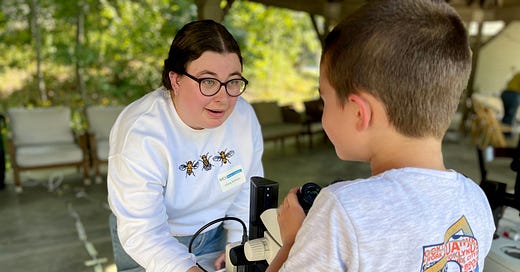BAR HARBOR—Scientists at the MDI Biological Laboratory mingled with children on the lawn of its Salsbury Cove campus this week. They laughed, peered into microscopes, examined the properties of light, and touched rainbows. They also ate a bit of ice cream.
The annual Family Science Night at MDI Bio Lab promotes scientific literacy. It does that by bringing science to life. It does a little more. It creates connections and memories and knowledge.
“Eventually it’s all going to wind up in rivers and go into the ocean so it’s really important that you don’t litter because that trash winds up in the ocean and then fishes eat it and microplastics get in our water and then we’re drinking plastic and it’s just bad,” one scientist from the Discovery Museum told kids at her table.
“Cultivate Curiosity” was emblazoned on her apron.
Across the lawn, a small girl rattled a big plastic bucket full of marbles to simulate the work of the kidney. Others peered into microscopes, touched starfish, colored, and learned.
“This activity is trying to teach kids how eyes work,” one scientist said, standing by a large dark box set on an outdoor table. “And its when light comes through the cornea, the image you see is projected into the back of your eye and sent to the back of your brain.”
Families went from one hands-on station to another and possibly took advantage of the Darling’s ice cream truck, but the focus was on science and exploration amongst a group of enthusiastic and educational scientists scattered across the pathway at their respective stations.
In the open-air shed Sam Cousins enthusiastically explained things in simple terms while a fake, bright purple, fuzzy worm dangled out of his shirt pocket.
“They have brains like we do. They have muscles like we do. Right? So if we can study how they work in them?” Cousins told a girl and her mom.
“He’s science-ing,” one girl whispered.
“He is,” her mom agreed.
The lab is a place where science becomes a verb.
Nearby, Chloe Sullivan explained science equipment, equally enthusiastic. Reilly Hedden supervised a child (and then an octogenarian) trying to stick balls on a fish blindfolded.
Sebe Lukhele oversaw a young man at a microscope with great patience and care. After a couple moments, the boy looked up at him with awe.
“You see it?” Lukele asked.
“I do.”
The event, hosted every year by MDI Biological Laboratory is about science, but it’s also about those moments, where kids interact with people absolutely passionate about science and how it can make the world better.
“Family Science Night promotes scientific literacy by bringing science to life. This event is an important part of the curriculum for our undergraduate summer fellows, serving as a practical application of the skills developed in their Communicating Science class. Children and families explore, experiment and talk about science at interactive stations guided by our scientists and their students. Student researchers participating in MDI Bio Lab’s undergraduate summer research fellowship program design and produce a wide variety of hands-on activities to explain their biomedical research,” according to information from the MDI Bio Lab.
It’s just another component of how the lab encourages both the community and young people across the state to have an interest, or at least an interaction, with science.
This spring, the MDI Bio Lab published and patented a novel method to reduce skin pigmentation.
MDI Bio Lab’s “Healthy Water/Healthy Aging” citizen-engaged science initiative collaborates with other institutions; it provides outreach, testing, and response options for varied contaminants found in Maine well water, while examining their health effects over time.
The lab also hosts and lobbies for Idea Network of Biomedical Research Excellence (INBRE).
Those are just three examples of the big things that are happening at the lab all the time: things that impact lives and the economy.
There are nearly 500 life science companies in Maine, Senator Susan Collins said last year at a visit to the lab.
“Together those companies have created nearly 10,000 Maine jobs,” she said.
Those jobs, she said, are great ones, with average incomes over $100,000 a year. It has directly invested $87 million in Maine so far.
The biomedical sector has grown by 45% in the past five years, said Dr. Hermann Hallier, president of the laboratory. INBRE is the “backbone of Maine’s live science sector,” he said.
Those are important metrics, but in a field full of data and facts, what INBRE has done, many stressed, is create opportunity in young people who are involved.
Making science accessible, fun, and interesting is part of what family night is about. Moments of interaction elicit giggles one moment, looks of understanding the next, and after that, there is sometimes a look of awe.
They are science-ing here. And that’s pretty cool.
About MDI Biological Laboratory
For more than 125 years, MDI Bio Lab has been a center for training and research in comparative biology. In the last two decades its biomedical research has focused on aging, regeneration, and environmental toxins.
The Laboratory houses 11 research groups staffed by an international team of world-class scientists and graduate students. It also leads a statewide network of colleges, universities and research institutions that collaborate to provide training, research experiences and financial support to help young Mainers play a bigger role in today's biomedical revolution.
Located on Maine’s rugged coast, the Laboratory’s 100+ acre campus houses research facilities, cottages and dorms that house visiting scientists and students. It is also home to MDI Bioscience, a subsidiary working to design innovative techniques to speed the drug discovery process.
The Bar Harbor Story is generously sponsored by Rick Osann Art.
LINKS TO LEARN MORE
Photos: Carrie Jones/Bar Harbor Story (our sister publication)
Follow us via our sister publication on Facebook. And as a reminder, you can easily view all our past stories and press releases here.































